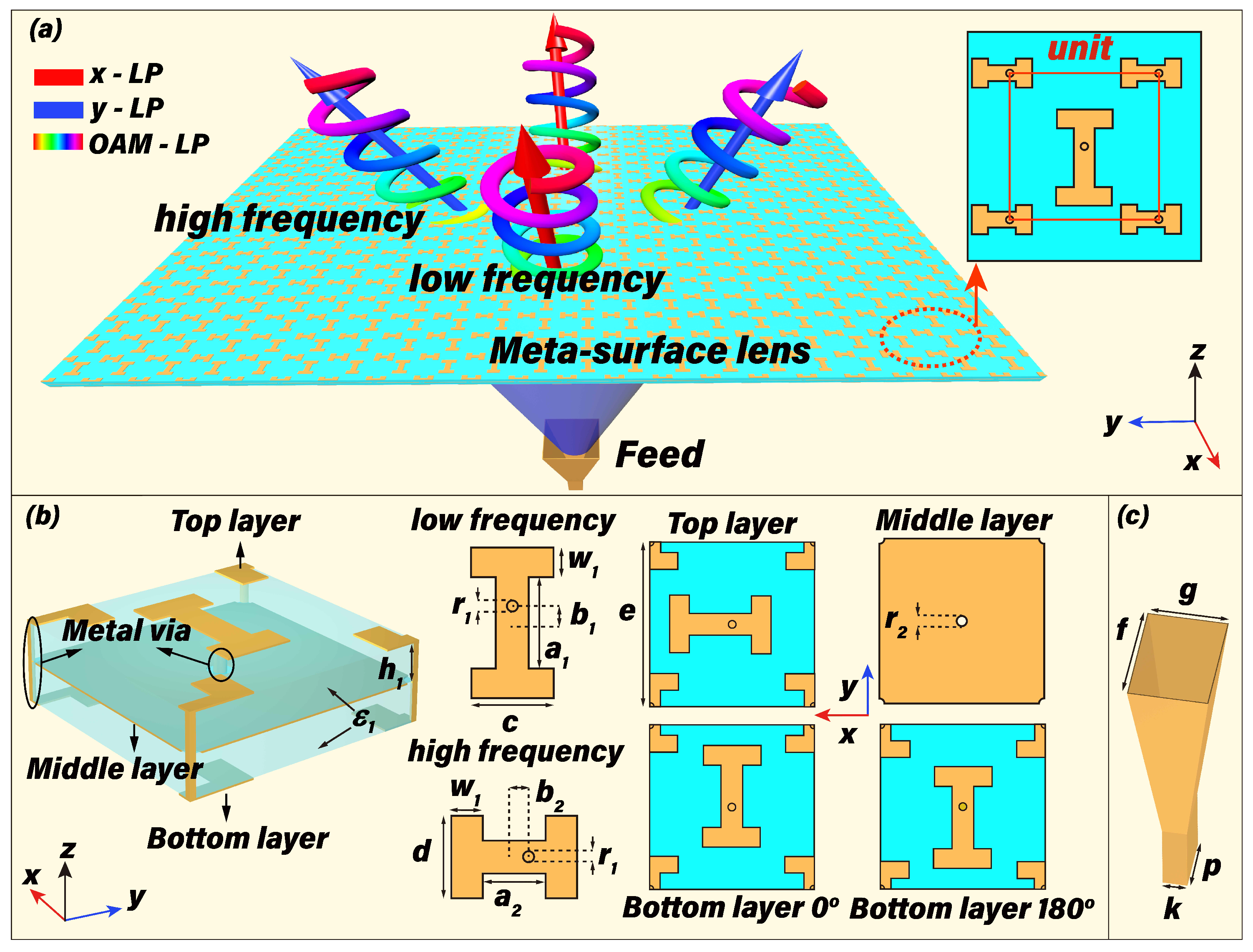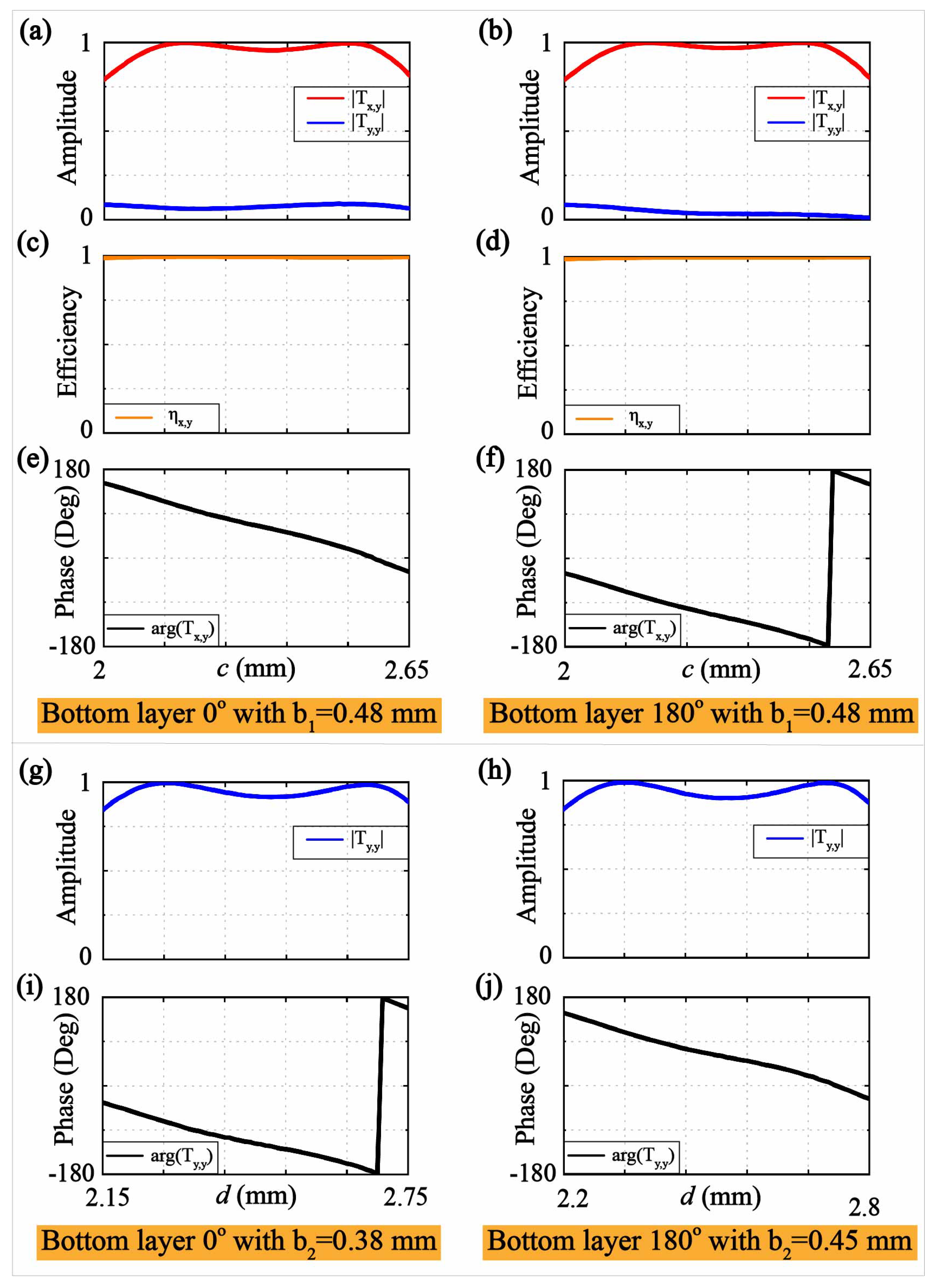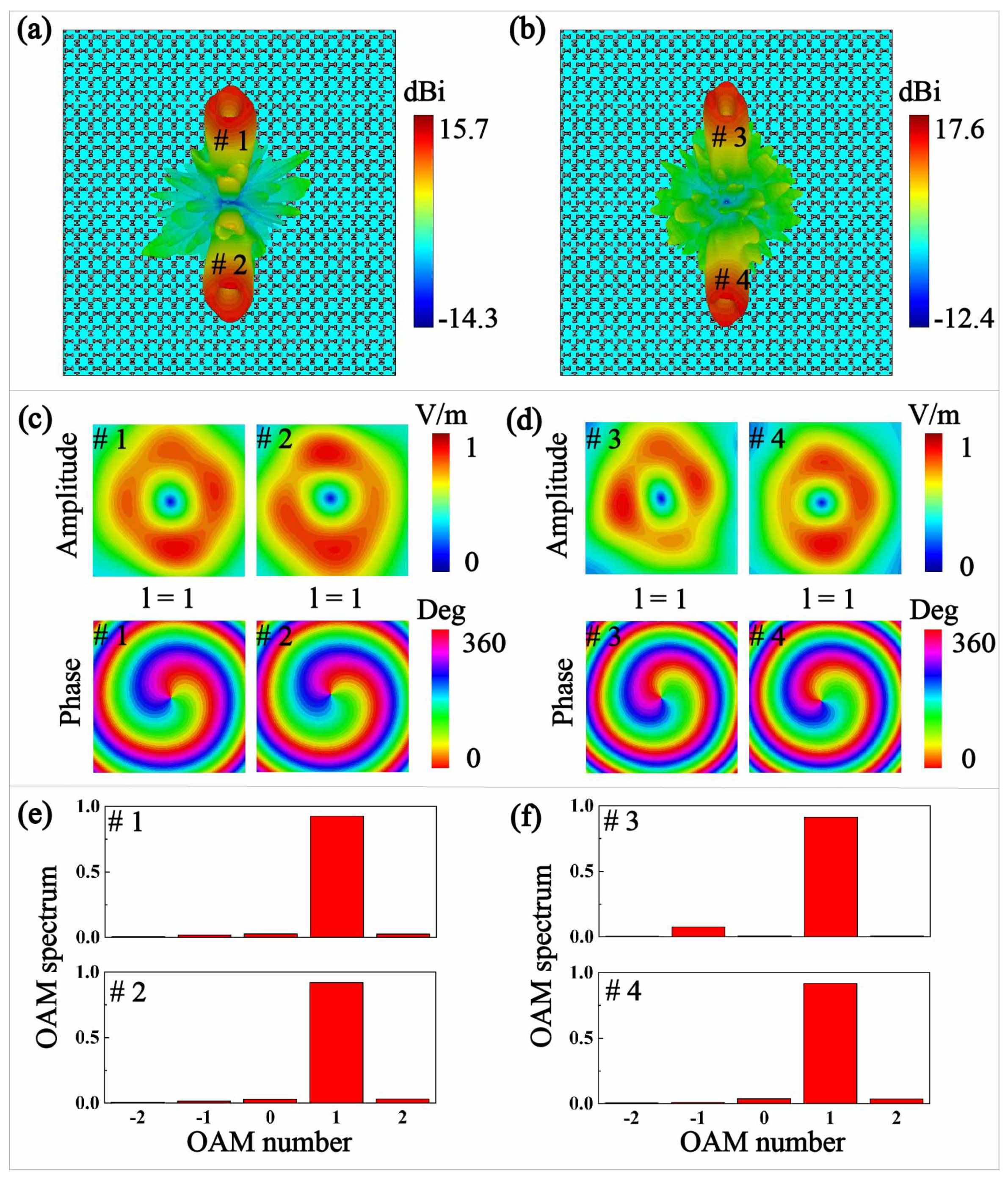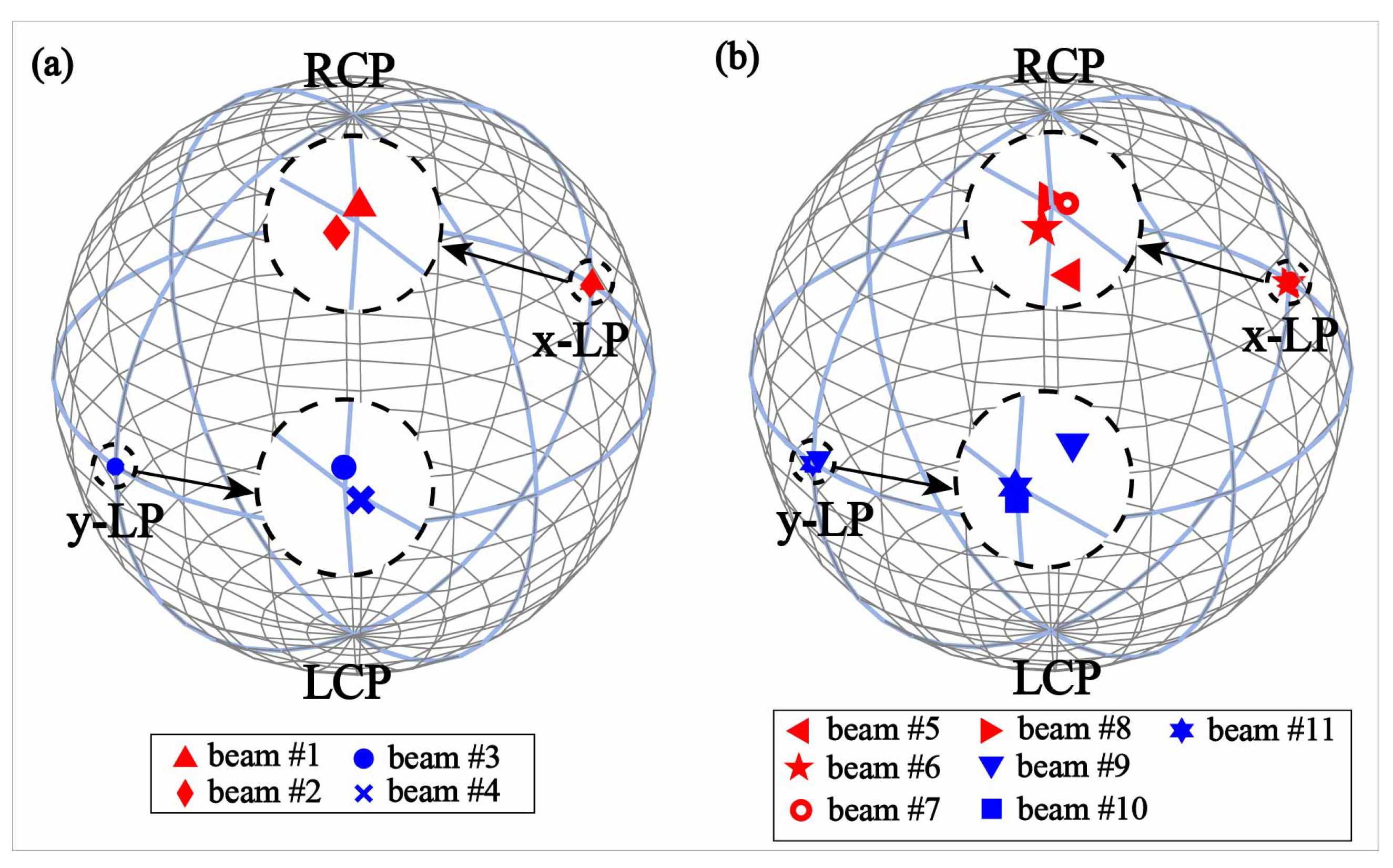Generating Different Polarized Multiple Vortex Beams at Different Frequencies from Laminated Meta-Surface Lenses
Abstract
:1. Introduction
2. Design and Numerical Results
3. Conclusions
Author Contributions
Funding
Institutional Review Board Statement
Informed Consent Statement
Data Availability Statement
Conflicts of Interest
References
- Mahmouli, F.E.; Walker, S.D. 4-Gbps uncompressed video transmission over a 60-GHz orbital angular momentum wireless channel. IEEE Wirel. Commun. Lett. 2013, 2, 223–226. [Google Scholar] [CrossRef]
- Yan, Y.; Xie, G.; Lavery, M.P.J.; Huang, H.; Ahmed, N.; Bao, C.; Ren, Y.; Cao, Y.; Li, L.; Zhao, Z.; et al. High-capacity millimetre-wave communications with orbital angular momentum multiplexing. Nat. Commun. 2014, 5, 4876. [Google Scholar] [CrossRef] [PubMed] [Green Version]
- Gong, Y.; Wang, R.; Deng, Y.; Zhang, B.; Wang, N.; Li, N.; Wang, P. Generation and transmission of OAM-carrying vortex beams using circular antenna array. IEEE Trans. Antennas Propag. 2017, 65, 2940–2949. [Google Scholar] [CrossRef]
- Park, W.; Wang, L.; Brüns, H.D.; Kam, D.G.; Schuster, C. Introducing a mixed-mode matrix for investigation of wireless communication related to orbital angular momentum. IEEE Trans. Antennas Propag. 2018, 67, 1719–1728. [Google Scholar] [CrossRef]
- Chen, R.; Long, W.X.; Wang, X.; Jiandong, L. Multi-mode OAM radio waves: Generation, angle of arrival estimation and reception with UCAs. IEEE Trans. Wirel. Commun. 2020, 19, 6932–6947. [Google Scholar] [CrossRef]
- Lee, I.; Sawant, A.; Choi, E.M. High-Directivity Orbital Angular Momentum Antenna for Millimeter-Wave Wireless Communications. IEEE Trans. Antennas Propag. 2020, 69, 4189–4194. [Google Scholar] [CrossRef]
- Hu, T.; Wang, Y.; Liao, X.; Zhang, J. OAM-Based Beam Selection for Indoor Millimeter Wave MU-MIMO Systems. IEEE Commun. Lett. 2021, 25, 1702–1706. [Google Scholar] [CrossRef]
- Genevet, P.; Yu, N.; Aieta, F.; Lin, J.; Kats, M.A.; Blanchard, R.; Scully, M.O.; Gaburro, Z.; Capasso, F. Ultra-thin plasmonic optical vortex plate based on phase discontinuities. Appl. Phys. Lett. 2012, 100, 013101. [Google Scholar] [CrossRef] [Green Version]
- Zhang, Y.; Lyu, Y.; Wang, H.; Zhang, X.; Jin, X. Transforming surface wave to propagating OAM vortex wave via flat dispersive metasurface in radio frequency. IEEE Antennas Wirel. Propag. Lett. 2017, 17, 172–175. [Google Scholar] [CrossRef]
- Zhang, K.; Yuan, Y.; Zhang, D.; Ding, X.; Ratni, B.; Burokur, S.N.; Lu, M.; Tang, K.; Wu, Q. Phase-engineered metalenses to generate converging and non-diffractive vortex beam carrying orbital angular momentum in microwave region. Opt. Express 2018, 26, 1351–1360. [Google Scholar] [CrossRef]
- Qin, F.; Wan, L.; Li, L.; Zhang, H.; Wei, G.; Gao, S. A transmission metasurface for generating OAM beams. IEEE Antennas Wirel. Propag. Lett. 2018, 17, 1793–1796. [Google Scholar] [CrossRef]
- Bi, F.; Ba, Z.; Wang, X. Metasurface-based broadband orbital angular momentum generator in millimeter wave region. Opt. Express 2018, 26, 25693–25705. [Google Scholar] [CrossRef]
- Yang, L.J.; Sun, S.; Wei, E.I. Ultrawideband reflection-type metasurface for generating integer and fractional orbital angular momentum. IEEE Trans. Antennas Propag. 2019, 68, 2166–2175. [Google Scholar] [CrossRef] [Green Version]
- Wang, H.; Li, Y.; Han, Y.; Fan, Y.; Sui, S.; Chen, H.; Wang, J.; Cheng, Q.; Cui, T.; Qu, S. Vortex beam generated by circular-polarized metasurface reflector antenna. J. Phys. D Appl. Phys. 2019, 52, 255306. [Google Scholar] [CrossRef]
- Lv, H.H.; Huang, Q.L.; Yi, X.J.; Hou, J.Q.; Shi, X.W. Low-profile transmitting metasurface using single dielectric substrate for OAM generation. IEEE Antennas Wirel. Propag. Lett. 2020, 19, 881–885. [Google Scholar] [CrossRef]
- Sroor, H.; Huang, Y.W.; Sephton, B.; Naidoo, D.; Valles, A.; Ginis, V.; Qiu, C.W.; Ambrosio, A.; Capasso, F.; Forbes, A. High-purity orbital angular momentum states from a visible metasurface laser. Nat. Photonics 2020, 14, 498–503. [Google Scholar] [CrossRef]
- Li, Y.; Li, X.; Chen, L.; Pu, M.; Jin, J.; Hong, M.; Luo, X. Orbital angular momentum multiplexing and demultiplexing by a single metasurface. Adv. Opt. Mater. 2017, 5, 1600502. [Google Scholar] [CrossRef]
- Zhang, D.; Cao, X.; Yang, H.; Gao, J.; Zhu, X. Multiple OAM vortex beams generation using 1-bit metasurface. Opt. Express 2018, 26, 24804–24815. [Google Scholar] [CrossRef]
- Ding, G.; Chen, K.; Luo, X.; Zhao, J.; Jiang, T.; Feng, Y. Dual-helicity decoupled coding metasurface for independent spin-to-orbital angular momentum conversion. Phys. Rev. Appl. 2019, 11, 044043. [Google Scholar] [CrossRef]
- Karimipour, M.; Komjani, N.; Aryanian, I. Holographic-inspired multiple circularly polarized vortex-beam generation with flexible topological charges and beam directions. Phys. Rev. Appl. 2019, 11, 054027. [Google Scholar] [CrossRef]
- Meng, X.; Wu, J.; Wu, Z.; Yang, L.; Huang, L.; Li, X.; Qu, T.; Wu, Z. Generation of multiple beams carrying different orbital angular momentum modes based on anisotropic holographic metasurfaces in the radio-frequency domain. Appl. Phys. Lett. 2019, 114, 093504. [Google Scholar] [CrossRef]
- Huang, H.F.; Xie, S.H. Single-layer substrate wideband reflectarray with dual-polarization for multiple OAM beams. OSA Contin. 2021, 4, 2082–2090. [Google Scholar] [CrossRef]
- Grady, N.K.; Heyes, J.E.; Chowdhury, D.R.; Zeng, Y.; Reiten, M.T.; Azad, A.K.; Taylor, A.J.; Dalvit, D.A.; Chen, H.T. Terahertz metamaterials for linear polarization conversion and anomalous refraction. Science 2013, 340, 1304–1307. [Google Scholar] [CrossRef] [Green Version]
- Liu, W.; Chen, S.; Li, Z.; Cheng, H.; Yu, P.; Li, J.; Tian, J. Realization of broadband cross-polarization conversion in transmission mode in the terahertz region using a single-layer metasurface. Opt. Lett. 2015, 40, 3185–3188. [Google Scholar] [CrossRef] [PubMed]
- Ma, Q.; Shi, C.B.; Bai, G.D.; Chen, T.Y.; Noor, A.; Cui, T.J. Beam-editing coding metasurfaces based on polarization bit and orbital-angular-momentum-mode bit. Adv. Opt. Mater. 2017, 5, 1700548. [Google Scholar] [CrossRef]
- Yang, J.; Zhang, C.; Ma, H.; Yuan, W.; Yang, L.; Ke, J.; Chen, M.; Mahmoud, A.; Cheng, Q.; Cui, T. Tailoring polarization states of multiple beams that carry different topological charges of orbital angular momentums. Opt. Express 2018, 26, 31664–31674. [Google Scholar] [CrossRef]
- Guan, C.; Liu, J.; Ding, X.; Wang, Z.; Zhang, K.; Li, H.; Jin, M.; Burokur, S.N.; Wu, Q. Dual-polarized multiplexed meta-holograms utilizing coding metasurface. Nanophotonics 2020, 9, 3605–3613. [Google Scholar] [CrossRef]
- Liu, C.; Gao, R.; Liu, S.; Shi, P. Meander-line based high-efficiency ultrawideband linear cross-polarization conversion metasurface. Appl. Phys. Express 2021, 14, 074001. [Google Scholar] [CrossRef]
- Yao, E.; Franke-Arnold, S.; Courtial, J.; Barnett, S.; Padgett, M. Fourier relationship between angular position and optical orbital angular momentum. Opt. Express 2006, 14, 9071–9076. [Google Scholar] [CrossRef] [PubMed] [Green Version]
- Jack, B.; Padgett, M.J.; Franke-Arnold, S. Angular diffraction. New J. Phys. 2008, 10, 103013. [Google Scholar] [CrossRef]






| Structural Parameters | Value | Structural Parameters | Value |
|---|---|---|---|
| 2.6 mm | e | 8 mm | |
| 1.3 mm | f | 31.2 mm | |
| 1 mm | g | 24.4 mm | |
| 0.4 mm | k | 7.5 mm | |
| 0.8 mm | p | 15.9 mm | |
| 1 mm | 3.5 |
Publisher’s Note: MDPI stays neutral with regard to jurisdictional claims in published maps and institutional affiliations. |
© 2021 by the authors. Licensee MDPI, Basel, Switzerland. This article is an open access article distributed under the terms and conditions of the Creative Commons Attribution (CC BY) license (https://creativecommons.org/licenses/by/4.0/).
Share and Cite
Gao, P.; Yang, R. Generating Different Polarized Multiple Vortex Beams at Different Frequencies from Laminated Meta-Surface Lenses. Micromachines 2022, 13, 61. https://doi.org/10.3390/mi13010061
Gao P, Yang R. Generating Different Polarized Multiple Vortex Beams at Different Frequencies from Laminated Meta-Surface Lenses. Micromachines. 2022; 13(1):61. https://doi.org/10.3390/mi13010061
Chicago/Turabian StyleGao, Pengfei, and Rui Yang. 2022. "Generating Different Polarized Multiple Vortex Beams at Different Frequencies from Laminated Meta-Surface Lenses" Micromachines 13, no. 1: 61. https://doi.org/10.3390/mi13010061
APA StyleGao, P., & Yang, R. (2022). Generating Different Polarized Multiple Vortex Beams at Different Frequencies from Laminated Meta-Surface Lenses. Micromachines, 13(1), 61. https://doi.org/10.3390/mi13010061







